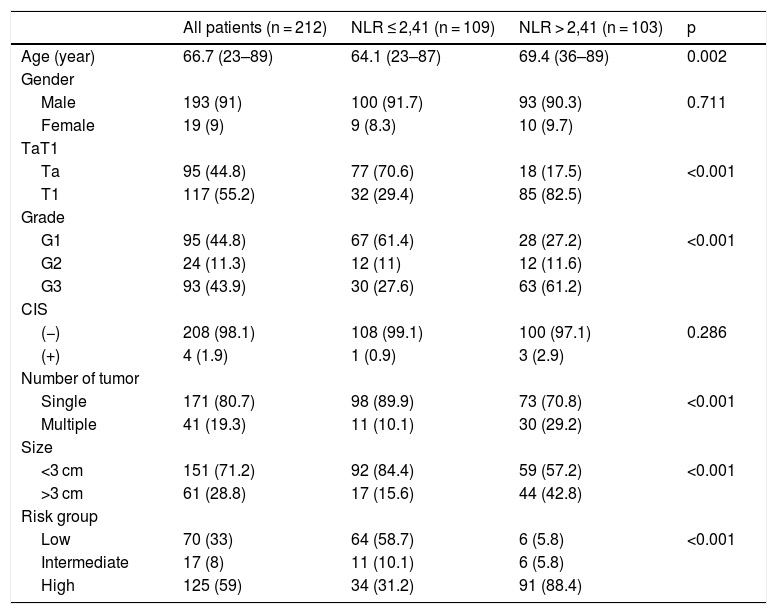Aim of this study is to evaluate the correlation between European Organization for Research and Treatment of Cancer (EORTC) risk score and neutrophil-lymphocyte ratio (NLR) in patients with non-muscle invasive bladder cancer (NMIBC) and the relationship between NLR and risk groups.
MethodsWe retrospectively reviewed data of 212 patients with NMIBC were included in the study. The tumors were graded according to the 1973 World Health Organization grading system and the tumor node metastasis (TNM) 2012 staging system. Patients were categorized low, intermediate and high risk for recurrence and progression, according to European Association of Urology guidelines. Serum values for the NLR were measured on the day before the operation to ascertain the baseline value for neutrophil and lymphocyte counts and statistically analyzed.
ResultsOf the 212 patients, 193 were male and 19 were female. Mean age was 66.7. Mean NLR score was 3.04 ± 2.11. T1 tumors, G3 tumors, multiple tumors and >3 cm tumors seen mostly in patients with NLR > 2.41. Low, intermediate and high risk groups compared and NLR rates were significantly higher in high risk group patients (p < 0.001). When the correlation between NLR and EORTC recurrence and progression scores was evaluated, it was observed that as NLR value increased, recurrence (r = 0.252 p < 0.001) and progression (r = 0.145 p = 0.034) scores increased significantly.
ConclusionsThis study demonstrated the association of high NLR value with T1 tumor, high grade, multiple tumor, >3 cm tumor and EORTC high risk group in NMIBC patients. There was also a positive correlation between NLR and EORTC recurrence and progression scores.
El objetivo del presente estudio es evaluar la correlación entre la puntuación de riesgo de la Organización Europea para la Investigación y Tratamiento del Cáncer (EORTC, por sus siglas en inglés) y el índice neutrófilo/linfocito (INL) en pacientes con cáncer de vejiga no músculo-invasivo (CVNMI), y la relación entre el INL y los grupos de riesgo.
MétodosSe revisaron retrospectivamente los datos de 212 pacientes con CVNMI incluidos en el estudio. Los tumores se clasificaron de acuerdo con el sistema de la Organización Mundial de la Salud de 1973 y el sistema TMN de estadificación (tumor, ganglio y metástasis) de 2002. Siguiendo las directrices de la Asociación Europea de Urología, se llevó a cabo la estratificación de los pacientes en grupos de bajo, intermedio y alto riesgo para recidiva y progresión. El día previo a la operación se midieron y analizaron los valores séricos del INL para determinar el valor basal de neutrófilos y linfocitos.
ResultadosDe los 212 pacientes, 193 eran hombres y 19 mujeres. La media de edad fue 66,7. La puntuación media de INL fue de 3,04 ± 2,11. Se encontró una mayoría de Tumores T1, tumores G3, tumores múltiples y tumores de >3 cm en pacientes con INL > 2.41. Tras comparar los tres grupos de riesgo, se obtuvieron tasas de INL significativamente mayores en los pacientes del grupo de alto riesgo (p < 0.001). Al evaluar la correlación entre las puntuaciones de recidiva y progresión de la INL y la EORTC, se observó que un valor elevado del INL se asocia a un aumento significativo en la puntuación de recidiva (r = 0.252 p < 0.001) y progresión (r = 0.145 p = 0.034).
ConclusionesEste estudio demostró la asociación entre un INL alto con los tumores T1, de grado alto, tumores múltiples, tumores de > 3 cm y con el grupo de alto riesgo EORTC en pacientes con CVNMI. También hubo una correlación positiva de la recidiva y progresión entre INL y EORTC.









